If you’re in a hurry and just want to figure out the differences between Sandisk vs PNY SDXC cards then here is what I recommend:
Get the Sandisk SDXC Cards if:
- Your camera supports the increase in write speed of ~90 MB/s
- You take most of your photos in RAW format and use burst mode frequently.
- If you need a 1 TB memory card capacity.
- If you tend to transfer large amounts of photo and video files at one time.
Get the PNY SDXC Card if:
- Your camera does not support the increase in write speed of ~90 MB/s.
- You want to save some money.
- You take most of your photos in JPEG format or you don’t use burst mode.
- If you only transfer small amounts of photos and video files at one time.
If you have some time, then stick around! I’m also going to be going over many other important details about high-speed memory cards including the following that can help you pick the best one for your needs:
- What are UHS (Ultra High Speed), classes?
- What is Video Speed Class?
- The difference between UHS-I, UHS-II, and UHS-III.
- Memory card capacity and what to expect.
- Write speed/transfer speed comparison between Sandisk and PNY
- Alternatives to the Sandisk and PNY SD cards.
What to Consider Before Buying a High-Speed Memory Card for your Camera

Getting a high-speed SD card for your camera is something most people don’t think twice about. They’re usually just trying to find the cheapest option with the most storage possible, so it’s good to see that you’re doing your homework before spending your hard-earned money.
A high-quality SD card is one of those things that you never notice until something goes wrong. If you choose the right one that can handle the photography and videography specs on your camera, you’ll never notice it.
However, if you choose the wrong one, you’ll notice it right away. You might be on a once in a lifetime bird watching trip and you finally spot the rare bird you flew across the world to see.
But then…
While you’re taking high-speed burst photos of that rare bird, you notice that the write speed of the SD card can’t keep up with the file sizes of your camera and you miss some amazing photo opportunities.
Or
You might be on your dream trip to Iceland. When you finally get to the Glacier Lagoon in Jökulsárlón for sunrise, you think it’s the perfect time to capture some 4k video footage to share with your family and friends.
But then…
When you go to the video record mode in your camera, you get an error message telling you that you have to switch to a UHS-I U3 compatible memory card to record in 4K.
These are just exaggerations of what could happen, but situations like these have happened to me before when I was out shooting and could happen to anyone.
Here are some points to consider when picking out the right high-speed SD card for your camera especially when it comes down to Sandisk vs PNY SDXC card options.

UHS (Ultra High Speed) Classes
The UHS (Ultra High Speed) classification was designed by the SD Association and introduced into the market in 2009. This speed classification lets you know the minimum worst-case sustained writing speed performance for when you’re recording video.
There are two different UHS (Ultra High Speed) speed classifications which are UHS Class 1 and UHS Class 3. UHS Class 1 has a minimum sustained writing speed of 10 MB/s while UHS Class 3 has a minimum sustained writing speed of 30MB/s. The symbol for the UHS Class on the SD card looks like this.
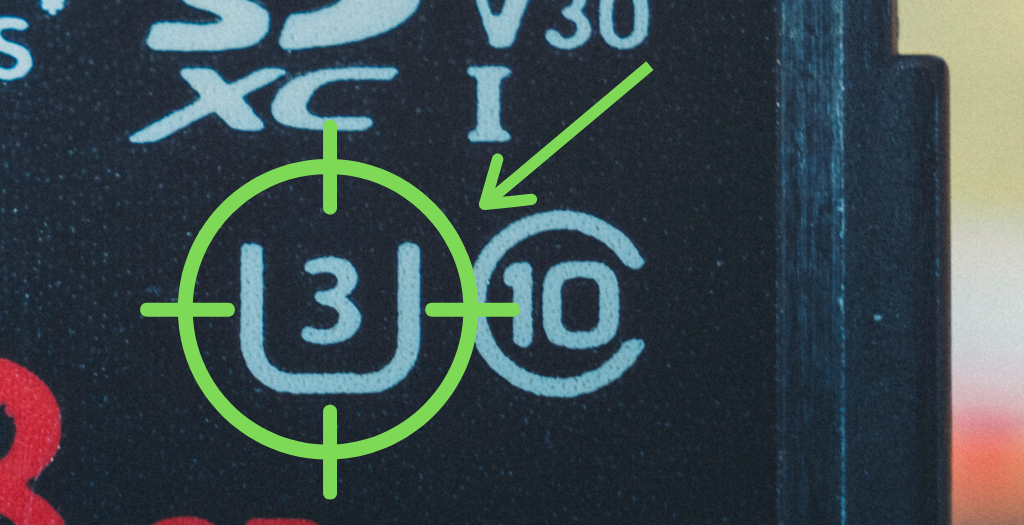
What’s important for you to remember just in case you have old SD cards laying around is that, for the most part, to record 4K video, you will need a UHS Class 3 SD card.
All the Sandisk and PNY memory cards we will go over in this article are UHS Class 3.
Video Speed Class

The Video Speed Class was introduced by the SD Association in 2016 and it tells you what the minimum sustained write speed is for the memory card. This is important as many of the cameras nowadays can record high-resolution video at high bit rates, so you will need a memory card which can write at a certain sustained speed.
Currently, there are 5 different Video Speed Classes which are:
- V6: 6 MB/s
- V10: 10 MB/s
- V30: 30 MB/s
- V60: 60 MB/s
- V90: 90 MB/s
To give you an idea of what each Video Speed Class can handle, only the fastest V60 and V90 speed classes are capable of recording 8K video.
All the Sandisk memory cards and the PNY memory card that we will cover are V30 which can record 4K resolution.
UHS-I, UHS-II, and UHS-III

Another classification on the memory card you might notice is UHS, which stands for Ultra High Speed and it helps you understand the maximum high-speed transfer capabilities of the memory card. This is different from the UHS (Ultra High Speed) Classes that we went over which is the minimum sustained write speed.
Currently, there are three different types of UHS classification, UHS-I, UHS-II, and UHS-III, although UHS-III is a newly announced classification and has not hit the market yet.
As you go from UHS-I to UHS-II to UHS-III the maximum high-speed transfer rate also increases. Theoretically speaking, a higher UHS classification will give you faster write times when shooting photos in burst modes and will allow you to transfer files much faster.
Here are the maximum transfer speeds for each of the UHS classifications:
- UHS-I: Maximum speed of 104 MB/s
- UHS-II: Maximum speed of 312 MB/s
- UHS-III: Maximum speed of 624 MB/s
What’s important to understand is that UHS-II memory cards are much more expensive than UHS-I cards. Additionally, to take full advantage of a UHS-II memory card, you will need a camera that supports UHS-II cards and you will need a dedicated UHS-II card reader for when you transfer files.
All the Sandisk and PNY memory cards we will go over are UHS-I SD cards.
Memory Card Capacity

The amount of storage capacity you will need will be different for everyone depending on your camera and how you will be using it. If you will be taking photos in RAW format, shooting both JPEG + RAW, recording a lot of videos, or if you go out and shoot for long periods, a memory card with higher storage capacity will be better for you.
However, if you just take photos occasionally or if you shoot in JPEG format and don’t record lots of videos, a smaller size memory card capacity will work perfectly fine.
For me, my sweet spot is the 128GB SD card size. It’s big enough that I can go out for a shoot and take RAW photos and 4K video without worrying about running out of space. Yet, it’s small enough that it’s not too expensive and won’t be a big deal if I need to pick up another one.
Here are the number of images you can expect in uncompressed RAW format in a variety of storage sizes.
If you shoot in compressed RAW or JPEG, you can still get a rough idea of how many photos you will be able to take by comparing the file size of each one of your photos. (source: Sandisk)

And, for videographers, here are the number of minutes recording time you can store (source: Panasonic).
Just like the estimated number of photos, the total recording time is also an estimate.
Not every camera can record at 400 MB/s or 150 MB/s. If your camera records at a slower recording speed, this will still give you a rough estimate of how many minutes of record time you can expect with a 64 GB and 128 GB memory card.

PNY vs Sandisk – Is There a Difference?
SanDisk

Sandisk is one of the best-known memory cards in the world and you’ll likely find at least one Sandisk memory card in any photographer or videographers bag if you ask. I have owned many many many Sandisk cards during my time as a professional photographer and they have always been extremely reliable and durable.
The company is based out of San Jose, California and they manufacture all of their SD cards in China, which is pretty common for all SD card manufacturers. What you might not know is that in May of 2016 they were acquired by Western Digital, so Sandisk is part of a larger corporation.
When it comes to the SD cards themselves, we will be looking at the performance of the Sandisk Extreme 150 MB/s and the Sandisk Extreme Pro 170 MB/s compared to the PNY Elite Performance card.
SanDisk Extreme 150 MB/s SDXC Card

PROS
- Longevity—trusted by photographers and videographers worldwide and has been proven to be reliable in all situations.
- Made by a market leader
- Lifetime warranty if damaged during normal usage (depends on the region in the world).
- Shockproof, X-ray proof, and waterproof
- Faster write and read speed than the PNY Elite Performance Card
CONS
- More expensive than the PNY Elite Performance Card.
- 256 GB maximum capacity vs 1 TB for Sandisk Extreme Pro and 512 GB for PNY Elite Performance.
- Slightly slower write and read speed than the Sandisk Extreme Pro.
SanDisk Extreme Pro 170 MB/s SDXC Card

PROS
- Longevity—trusted by photographers and videographers worldwide and has been proven to be reliable in all situations.
- Made by a market leader
- Lifetime warranty if damaged during normal usage (depends on the region in the world)
- Shockproof, X-ray proof, and waterproof
- Fastest write and read speed of all 3 memory cards.
CONS
- More expensive than the PNY Elite Performance Card and Sandisk Extreme.
PNY
PNY is not as well known as Sandisk, but they also make quality memory cards that can fit in many photographers/videographers’ workflows. The best part is that you can usually find PNY memory cards at a cheaper price than Sandisk memory cards for the same storage capacity.
PNY is headquartered in Parsippany, New Jersey and they manufacture some of their memory cards, like the PNY Elite Performance in Korea, which is also pretty common. In addition to SD cards, they also make a wide selection of flash drives, USB drives, and graphics cards.
PNY Elite Performance SDXC Card

PROS
- At a cheaper price point than the Sandisk SD cards for the same storage capacity.
- Will still be able to support the maximum write speed for many cameras.
- Shockproof, X-ray proof, and waterproof
CONS
- Slower write and read speed than the Sandisk SDXC cards.
- 5-year warranty versus the lifetime warranty on Sandisk cards.
Maximum Write Speed Comparison
As I mentioned above, the maximum write speed that you will find in the Sandisk Extreme and Sandisk Extreme Pro is faster than the PNY Elite Performance SD card.
This makes the most difference for photographers, especially when using burst mode.
A higher maximum write speed will allow your camera to write to the memory card faster which will prevent your buffer from filling up too quickly. This means you will be able to continue to shoot instead of waiting for your camera buffer to clear before taking more photos.
Note: Again, maximum write speed is all about short bursts of photographic action and is different from sustained write speed which is what recording video uses.
Based on very thorough testing done by the good folks at https://www.cameramemoryspeed.com/ the fastest sequential write speed of the Sandisk and PNY SDXC 128 GB cards reached were the following for the 128 GB version of the memory card.
- Sandisk Extreme 128 GB 150 MB/s: Fastest benchmark write speed result was 89.1 MB/s.
- Sandisk Extreme Pro 128 GB 170 MB/s: Fastest benchmark write speed result was 89.1 MB/s
Compared to the PNY Elite Performance SDXC Card:
- PNY Elite Performance 128 GB: Fastest benchmark write speed result was 69.2 MB/s
Important Note About Camera Write Speed Performance
What’s important for you to realize is that to take full advantage of the increased write speed performance of the Sandisk SDXC cards, your camera needs to be able to support those write speeds. Each camera has a different maximum write speed, so it’s just as important to understand what that is when selecting a memory card.
Additionally, Some cameras support both UHS-I and UHS-II memory cards while others only support UHS-I. For dual memory card slot cameras, some will have one memory card slot which supports up to UHS-II, while others will support up to UHS-II in both memory card slots.
For example, the Sony a6400, a6500, and a6600 which are some of the most popular APS-C cameras in the market are capped at around 30 MB/s max write speed. This means that even though the Sandisk SD cards are faster than the PNY SD card, their write speed performance will be about the same at ~30 MB/s.
Most camera manufacturers do not publish what the write speed of its SD card slot is, so I’ve tried my best to collect as much information for you as possible.
Here is a list of the different estimated write speeds of the most popular cameras. If you don’t see your camera here and would like to add to this list, just let me know and I’d appreciate it!

Maximum Transfer/Read Speed Comparison
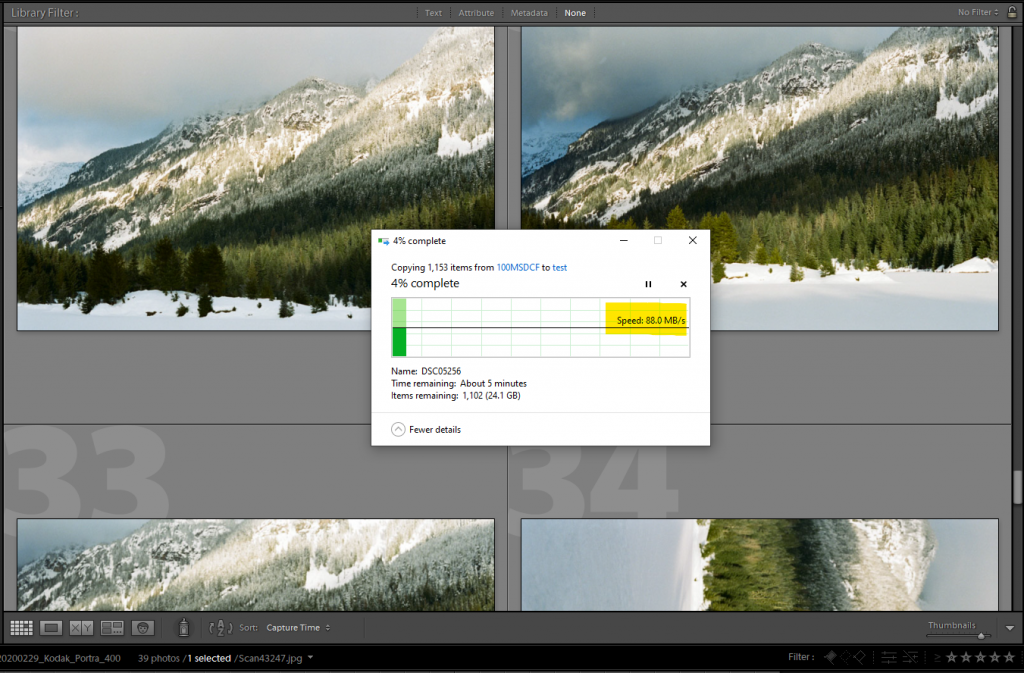
The maximum transfer/read speed is where you will find the biggest difference in terms of speed between the Sandisk and the PNY memory cards. The Sandisk has been tested to be able to produce up to almost double the transfer speed of the PNY memory card with a caveat being you’re using a dedicated high-speed memory card reader and have the newest USB port technology (ex. USB 3.0, USB- C, etc.)
Here are the maximum transfer speeds that were produced (source: https://www.cameramemoryspeed.com/) They obtained these maximum transfer speeds using a dedicated high-speed Sandisk SD card reader:
- Sandisk Extreme 128 GB 150 MB/s: The fastest benchmark transfer speed result was 153 MB/s.
- Sandisk Extreme Pro 128 GB 170 MB/s: Fastest benchmark transfer speed result was 176 MB/s
Compared to the PNY Elite Performance SDXC Card:
- PNY Elite Performance 128 GB: Fastest benchmark write speed result was 96.8 MB/s
Just keep in mind that this is the maximum transfer speed obtained. When you’re transferring files in real life, the transfer rate will fluctuate during the transfer process and may be impacted by different CPU processes running at the same time.
The transfer speed is important when you’re transferring the photos or videos to your computer or external hard drive.
How fast or slow the transfer speed you have isn’t that important if you’re only transferring small amounts of data at a time. However, if you shoot a lot of photos in RAW format or high-resolution video in 4K, having a memory card with higher read/transfer speeds will make a huge difference when you’re transferring these large file sizes to your computer or external hard drive.
As I mentioned already, what’s important for you to remember is that to maximize the increase in performance in read speed, you will need a dedicated SD card reader like this one from Sandisk and a USB 3.0 port in your computer that can support the increase in speed.
If you don’t have a dedicated SD card reader or the newest USB port technology in your computer, you will likely not benefit from the increase in read speed performance in the more expensive Sandisk cards.
Alternative Choices
If you’re looking for even faster write and read speeds than the 2 Sandisk memory cards that we went over, then a UHS-II SD card might be a better choice for you.
Here are 3 UHS-II memory cards and how they compare to the Sandisk and PNY memory cards.
1. Lexar Professional 2000x UHS-II SDXC Card

Lexar Professional 2000X vs Sandisk and PNY Memory Cards
- More than 3x the price of the Sandisk Extreme Pro and 7x more expensive than the PNY Elite Performance for the same capacity.
- Much faster read and write speed. Tested at a maximum read speed of 304.1 MB/s and write speed of 246.1 MB/s.
- The Lexar Professional 2000 X has a maximum capacity of 128 GB versus the larger capacity sizes such as 256 GB and 512 GB available to both the Sandisk and PNY SD cards.
2. ProGrade Digital UHS-II SDXC Card

ProGrade Digital vs Sandisk and PNY Memory Cards
- More than 3x the price of the Sandisk Extreme Pro and 7x more expensive than the PNY Elite Performance for the same capacity.
- Much faster read and write speed with a maximum reported read speed of 300 MB/s and maximum reported write speed of 250 MB/s.
- The ProGrade Digital UHS-II Card has a maximum capacity of 256 GB versus the larger capacity sizes such as 512 GB available to both the Sandisk and PNY SD cards.
3. Sony SF-G Tough Series UHS-II Card

Sony SF-G Tough Series vs Sandisk and PNY Memory Cards
- Much faster read and write speed. Tested at a maximum read speed of 298.3 MB/s and write speed of 267.5 MB/s.
- More than 5x the price of the Sandisk Extreme Pro and 11x more expensive than the PNY Elite Performance for the same capacity.
- Super tough construction that has been tested to withstand a drop up to 16 feet and is waterproof up to 16 feet as well.
- The Sony SF-G Tough Series memory card has a maximum capacity of 128 GB versus the larger capacity sizes such as 256 GB and 512 GB available to both the Sandisk and PNY SD cards.
Conclusion

I hope after reading this article you now have a much better understanding of the difference between the Sandisk and PNY SDXC memory cards. They are both great memory card brands and will get the job done, however, one brand may be a better fit than the other depending on how you use your camera.
Since both Sandisk and PNY cards are UHS Class 3, they are both able to record video at 4K resolution so the main performance differences will be found when you’re taking photos or transferring files.
Here is what I think:
Get the Sandisk Extreme or Sandisk Extreme Pro if:
- Your camera supports the increase in write speed of ~90 MB/s
- You take most of your photos in RAW format and use burst mode frequently.
- If you need a 1 TB memory card capacity.
- If you tend to transfer large amounts of photo and video files at one time.
Get the PNY Elite Performance if:
- Your camera does not support the increase in write speed of ~90 MB/s.
- You want to save some money.
- You take most of your photos in JPEG format or you don’t use burst mode.
- If you only transfer small amounts of photos and video files at one time.
Social Proof – What are People Saying?
Don’t just take my word for it. There have been many happy customers of both the Sandisk and PNY SDXC cards.
Here are just some of the positive reviews that I was able to find for the Sandisk Extreme, Sandisk Extreme Pro, and PNY Elite Performance memory cards.
SanDisk Extreme 150 MB/s SDXC Card
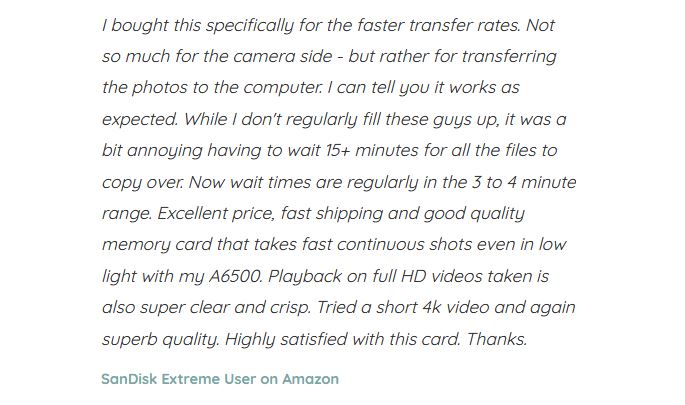
SanDisk Extreme Pro 170 MB/s SDXC Card

PNY Elite Performance SDXC Card
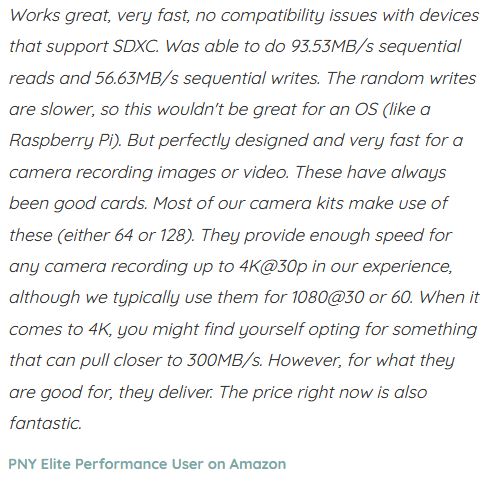

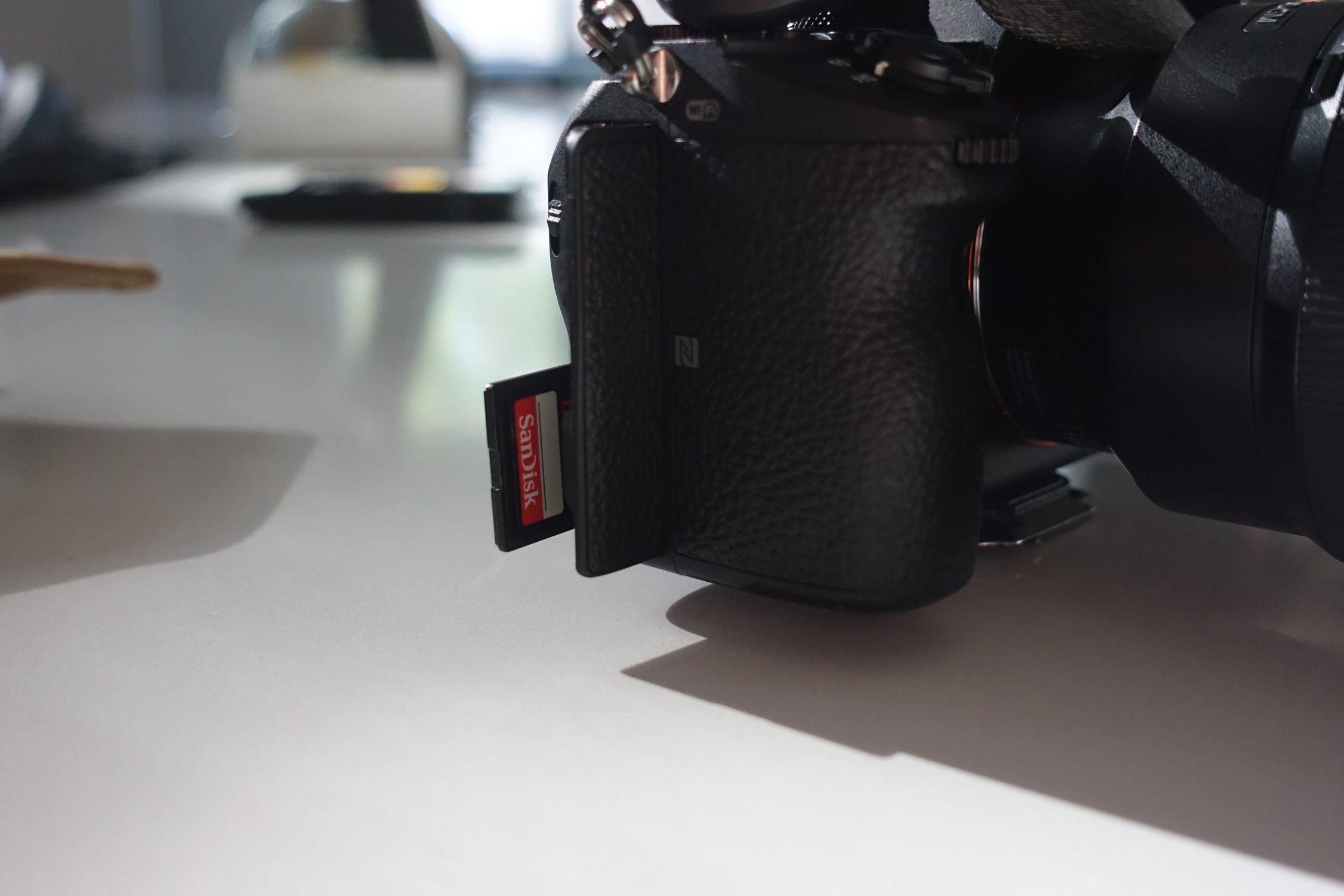
The best SD review I have read!
Good Job
thanks for reading!